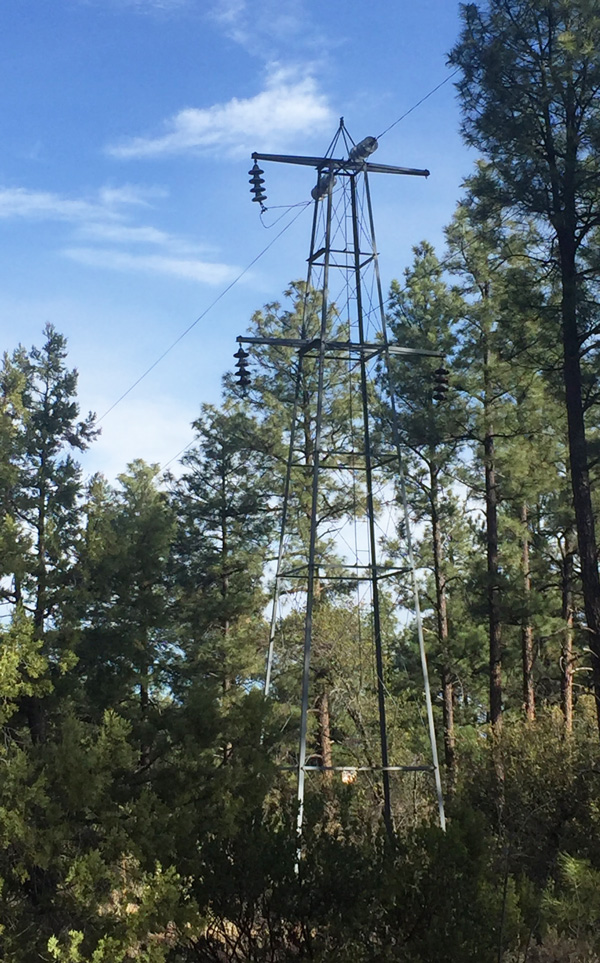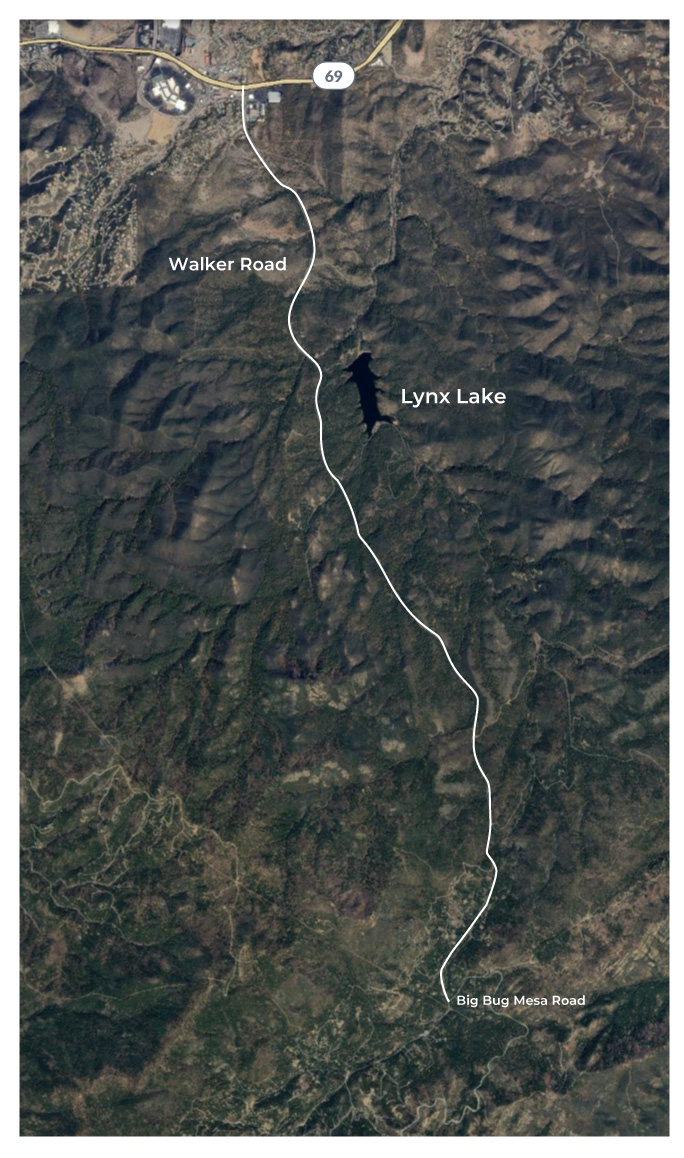Header
Walker Road Upgrade

aps
About the Walker Road Upgrade
We will remove the existing 4.4 miles of 12 kilovolt (kV) line southwest of Prescott and install a new 12 kV line along Walker Road between Big Bug Mesa Road and Liese Drive. The existing line has been providing power to the communities of Walker, Potato Patch and Goldwater Lake for nearly 100 years and is nearing the end of its operational life. The new overhead power line will be placed on 45’ to 60’ weathered steel poles, similar to poles that already exist along Walker Road.
While construction was set to begin in 2024, due to permitting delays, construction is now expected to begin in late 2026. We will continue to update this project page as we move through the permitting process and into construction.

Existing line nearing end of life
We continue to work diligently to resolve coordination design constraints and alignment alternatives for the 12 kV overhead line to be routed along Walker Road between Big Bug Mesa Road to Bald Mountain Road. Over the next few months, APS Land Agents will be contacting landowners in the area to discuss potential vegetation impacts. In January 2025, APS initiated the NEPA (National Environmental Policy Act) permit process. NEPA is designed to carefully review the potential environmental impacts of the project. We will also submit an environmental report to the Prescott National Forest outlining the Walker Road Project. The forest agency will open the report for public review and comment as part of this process.
We remain committed to keeping you informed about this project. Information regarding the public comment period and public meeting will be sent to community members in advance and will also be included on this webpage.

Prioritizing Reliability and Safety
This project will prioritize reliability, efficiency and safety while reducing wildfire risk. Benefits of the relocation include:
-
Quicker access - By moving the lines from their current location in a heavily forested area with severely restricted access (no access road), we will be able to restore power more quickly.
-
Enhanced reliability - By relocating the line, we are able to provide power from an additional substation. This creates a "backup", which should greatly reduce the frequency and length of unplanned outages in this area.
-
Wildfire safety & mitigation - The old line will be removed from a heavily forested area. The new line will be installed on a safer open path. The new poles will be weathered steel, which will help prevent them from failing or falling during a potential wildfire. Additionally, while the line can be deenergized in the event of an emergency, the new route will allow crews to access the line more quickly. Learn more about APS's wildfire mitigation strategy and public safety power shutoff program, which is to be used only during severe fire conditions.
-
Upgraded power lines - The new line will be equipped with upgraded wires to improve power quality as well as devices to protect birds.
-
Timeline - Relocation also reduces construction time and impacts.
Community Updates
Community Letter - June 2024
Community Letter - February 2023
Community Letter - November 2022
Project Brochure
Contact us
For questions or additional information regarding the project, please contact our Construction Outreach Consultant Teresa Makinen, MakPro, at 602-421-3069 or apsprojects@makprosvc.com or Darla DeVille, APS Public Affairs Manager, at 928-499-9135 or Darla.Deville@aps.com. Please reference work order #WE016235.
Project Hotline: 602-532-6222
FAQs
No, the siting selection process applies to overhead transmission lines of 115kV or greater, per the Arizona Corporation Commission requirements. However, APS may also elect to use this process for 69kV transmission lines. In this case, the power lines being relocated are lower voltage 12kV distribution lines.
Will APS need to acquire permits?
A portion of the proposed route along Walker Road will cross U.S. Forest Service land and may require a Federal environmental (NEPA) study that will take approximately a year to complete.
By moving the line from its current location in a heavily forested area with severely restricted access (no access roads), we will be able to restore power more quickly. The new poles will be weathered steel, which will improve evacuation routes by helping to prevent them from failing or falling during a potential wildfire. In addition, the new power poles will be equipped with avian protection devices.
Overhead power lines are easier to inspect and maintain, and also easier to identify and repair faults, compared to underground infrastructure. The new location along Walker Road will also allow us to deenergize the line more quickly in the unfortunate event of a nearby wildfire. Visit our website to learn more about APS's wildfire mitigation strategy and public safety power shutoff program, which is to be used only during severe fire conditions.
The weathered steel poles will be about 45-60 feet tall and about 3-4.5 feet in diameter at the base. These will be similar to poles that already exist along Walker Road today. These poles will be placed every 200 to 400 feet as the span length allows; the average span length is 262 feet between structures.
Will these poles look similar to those along Copper Basin Road?
No, Copper Basin Road power poles accommodate 69kV transmission line and are about 65-75 feet tall.
The new planned alignment is 7 miles in length, with the additional 2.6 miles being related to the circuitous nature of following Walker Road and will allow the area to be powered by multiple substations which improves redundancy and, therefore, reliability. This should also reduce the frequency and length of unplanned outages in this area in the future.
Placing power lines underground is significantly more expensive than placing power lines overhead. This is due to additional required construction plus the use of special materials and conductors required for underground use. In particular, trenching or boring for the entire length of the power line can be difficult and expensive.
Buried power lines can also extend power outages, as it may take additional time to locate a specific power issue, and take more time to access the fault and repair it. Additionally, underground systems can be prone to flooding in certain conditions.
Typically, lower voltage (distribution) lines are buried with new developments, as the additional cost to place the lines underground is passed onto home buyers or business owners by the developer through impact fees.
Why do some areas have underground power lines and others don't?
To help keep prices lower for all customers, and provide efficient access to our systems, our standard practice is overhead construction. However, there may be instances where underground installation takes place, such as through development agreements or where individual customers have paid for the lines to be placed underground through a utility facilities improvement district that is established by municipal and/or county authorities. The local municipal authority may establish an improvement district if approved by a majority of affected property owners. A district is a taxing authority, taxing affected property owners in order to raise funds for the additional cost of placing cables underground (See A.R.S. § 48-620).
There are several challenges that prevent APS from undergrounding in this area.
- Undergrounding power lines comes with high upfront costs shared by all APS customers, maintenance difficulties, shorter cable lifespan and complex permitting requirements.
- Due to soil conditions, undergrounding would require extreme and time-intensive construction measures such as blasting and deeper, wider trenches to safely install the underground wires.
- There is no straight path for the new line to be built; therefore, underground construction would require:
- installation of large concrete manholes throughout the project (including private property) and
- removal of additional trees and foliage. - Significantly extend the time for construction impacting all road traffic.
- Buried power lines can extend the length of power outages, requiring additional time to locate a specific power issue and repair the outage, especially in heavily wooded areas.
Trenching and installing power lines underground has historically been higher in cost than installing them overhead. Construction for the underground line is estimated at $35 million; however, this is not based on engineered drawings because the terrain and route challenges are so substantial that this option was ruled out in the internal planning process. The underground estimate is over 2.5 times higher than the proposed overhead route along Walker Road, and it is not prudent or responsible to pass those costs onto all APS customers when a safe, affordable, and technically more sound option exists.
What if residents in the area would like to pay for an underground installation?
The local municipal authority may establish an Improvement District, if approved by a majority of affected property owners. The District is a taxing authority, taxing affected property owners in order to raise funds for the additional cost of placing cables underground (See A.R.S. § 48-620). Due to the timeline for this project, we are expecting to begin construction in 2026. If an Improvement District is established, APS would then need to return to relocate the lines underground.






